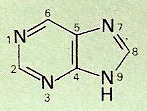purine
Purine, C5H4N4, is the parent compound of a class of organic bases of major biochemical importance. Purines are nitrogen-containing, organic bases, the molecules of which have a double-ring structure. They are the larger of the two types of nitrogenous base found in DNA and RNA (the other being pyrimidines). Adenine and guanine are purines. A combination of a purine and a pentose (5-carbon sugar) is a nucleoside, which when phosphorylated gives a nucleotide.
 |
| The structure of purine. Many of the most important
purine derivatives are substituted on the 2 and 6 carbon atoms.
|
Purines are synthesized in the body or produced by the digestion of certain proteins. Foods and other substances high in purines include, sardines, liver, kidneys, pulses, poultry, caffeine, and theophylline. Increased levels of purines in the body can cause hyperuricemia (a raised level of uric acid – the end-product of purine metabolism – in the blood), which may lead to gout.


